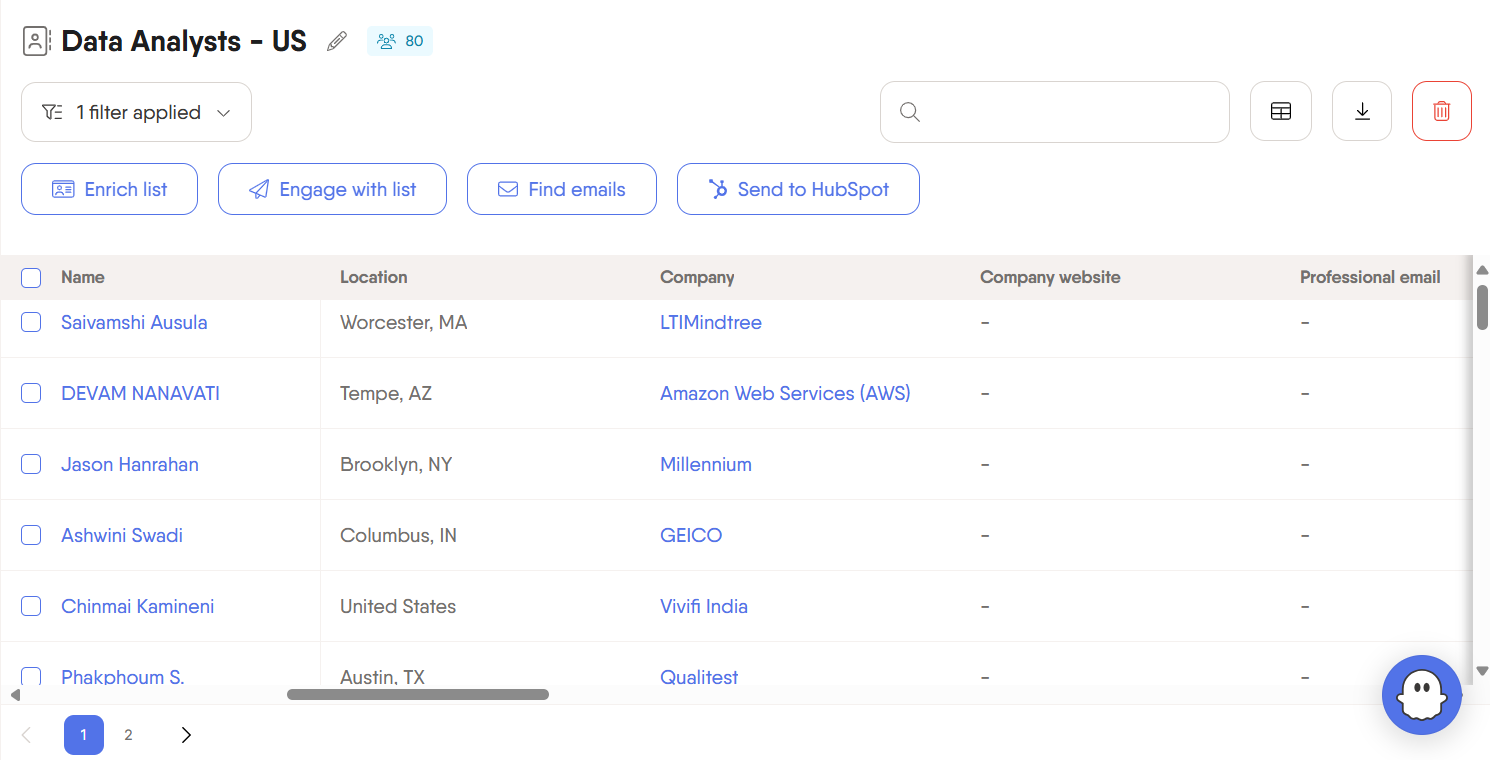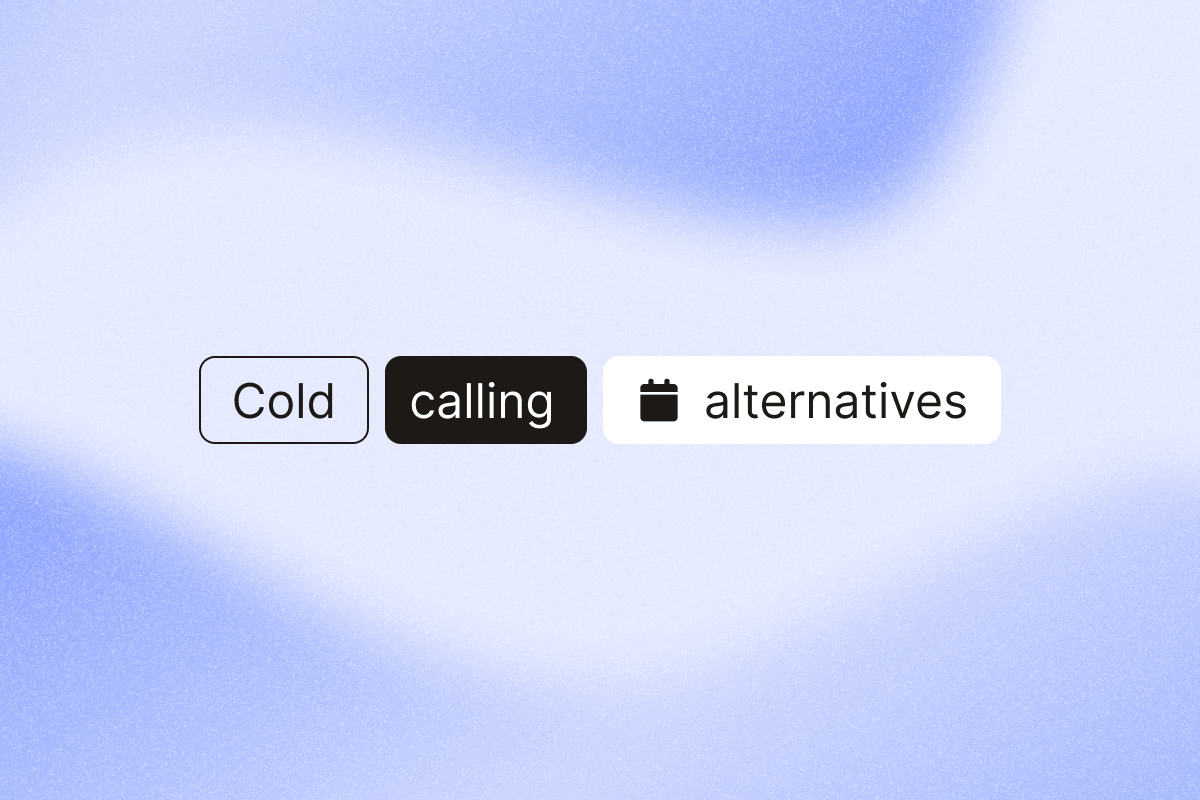Here’s your guide to attracting, engaging, and converting prospects without picking up the phone.
Ever had a prospect hang up on you seconds after they answered your call?
That’s what traditional cold calling is mostly about, a numbers game with low hit rates.
But is cold calling dead?
Recent data shows the average cold call success rate in 2025 at 2.3%, down sharply from 2024. That’s another reason to warm up prospects first.
Common reasons for rejection include:
- The prospect isn’t interested in your pitch
- You’re describing a problem they don’t have
Given these challenges, how do you generate leads and engage prospects? Focus your sales strategy on building relationships that turn cold leads into warm prospects. That’s where B2B cold calling alternatives can help your sales team.
In this guide, you’ll get seven proven alternatives to warm up prospects and book more qualified meetings. We’ll also show you how to build a scalable prospecting strategy using automation and AI tools.
B2B cold calling alternatives that consistently warm up leads
From social selling and email campaigns to content marketing, there are several ways to generate warm leads without making cold sales calls. Here’s how each tactic helps you start warmer conversations.
1. Warm up prospects with social selling on LinkedIn
Social selling puts you in your prospect’s feed so they recognize your name before you reach out. Instead of interrupting potential customers with unsolicited phone calls, you connect with them on social media platforms like LinkedIn.
Start by building familiarity before you pitch. The best way to do that is to follow their profile and engage with their content.
Like their posts and leave a specific comment about their point. For example: “Your take on SDR ramp time, what playbook cut it from 90 to 45 days?” This builds familiarity and keeps your follow-up from feeling like unsolicited outreach.
Automation Tip Box:
Manually tracking social media activity of hundreds of potential clients and engaging with their posts is inefficient.
Start by using PhantomBuster’s LinkedIn Search Export automation to export LinkedIn search results into a CSV. This helps you build a contact list of your target audience.
Next, use PhantomBuster’s LinkedIn Activity Extractor to find each lead’s recent posts. Use a recent quote or topic from their post in your first line (e.g., “Your take on PLG vs. sales-led…”).
Finally, automate engagement with PhantomBuster’s LinkedIn Auto Liker and LinkedIn Auto Commenter automations for a list of relevant posts. Schedule conservatively to stay within LinkedIn guidelines.
2. Send hyper-personalized cold emails that get replies
Cold email lets prospects respond on their time and can scale when it’s personalized.
Your subject line and first sentence must earn attention. Generic, promotional emails get ignored. Worse, your emails might land in the spam folder.
The key is to implement hyper-personalized email campaigns that speak to a prospect’s pain points and preferences.
Referencing recent company news or a piece of insightful content they shared shows you’ve done your research. The effort demonstrates respect for their time and boosts conversion rates.
The challenge, though, is collecting and analyzing customer data and developing personalized content. It’s something that 33% of marketers report struggling with.
AI and automation solve both: accurate data and fast personalization at scale. For example, 39% of marketers say AI-driven hyper-personalization will have the biggest impact on email automation.
Automation Tip Box:
Effective cold emailing requires two things: accurate contact details and personalization hooks.
Find verified emails with PhantomBuster’s Professional Email Finder automation. Next, use PhantomBuster’s LinkedIn Profile Scraper automation to gather 47 key data points, including job descriptions, LinkedIn headlines, previous job titles, and more. Use these details to write targeted email campaigns.
3. Attend networking events (both virtual and in-person)
Industry events and LinkedIn Lives put you in front of qualified buyers. They offer a unique chance to build genuine, face-to-face relationships with your target audience.
The real work on this lead generation strategy begins after the event, though. Implement a system to nurture leads you’ve met and not let those valuable connections go cold.
Organize the contact details of potential customers you met at the event and send timely follow-ups that reference your conversation.
Add warm leads to your customer relationship management (CRM) system or an email nurture sequence. Share a relevant asset within 24 to 48 hours, then ask if they’d like a short demo only after a positive reply.
4. Engage prospects in niche Slack communities
What if you could meet prospects where they are instead of disrupting their day with sales calls?
Niche Slack communities let you join ongoing problem-solver discussions with your ICP. They are hubs where potential leads discuss challenges and share solutions. Participating in these conversations establishes authority, credibility, and trustworthiness.
When you do send a direct message, you’re no longer a stranger but a familiar contributor, which is a much warmer approach than a typical cold call.
Automation Tip Box:
Turn community members into a qualified list with PhantomBuster’s Slack Channel User Extractor. It lets you extract participants from a targeted channel in your Slack workspace. Follow workspace rules and obtain consent before messaging members. Depending on the channel’s privacy settings, you might be able to access members’ email addresses, too.
Next, use PhantomBuster’s Slack Message Sender to send a relevant message that references your shared community and the specific thread. Send only to members who’ve opted in to DMs, making for a natural and effective outreach.
5. Use your content marketing to drive inbound leads
Consistent, helpful content pulls qualified prospects to you.
Create insightful content, such as blog posts, case studies, and whitepapers, that addresses potential customers’ interests, needs, and pain points.
Offer gated assets (checklists, e-books) with a clear CTA so visitors can request the resource and share their email.
With content marketing, you can generate awareness and drive organic traffic to your company website. Plus, it proves you understand their problems with real examples and results, thus driving your sales process.
6. Build a simple referral system
Word-of-mouth marketing is the most common source of brand discovery in the US, with 36% of internet users relying on it.
Referrals are often your lowest-cost, highest-trust leads. A warm introduction from a customer typically converts better than a first-touch email or LinkedIn message. It builds instant trust and increases the likelihood of conversions.
While many companies have informal referral programs, you need a well-defined system to track and maximize referrals. Regularly review your CRM data to identify happy customers who’d introduce you to similar businesses. A warm introduction has a much higher success rate than any cold outreach.
Take things up a notch by incentivizing referrals. Offer current customers add-ons, credits, or discounts for each new client they bring.
7. Use targeted local prospecting on Google Maps
If your target audience includes local businesses, Google Maps shows you nearby businesses with contact info you can verify. All you have to do is search using relevant categories, such as “IT service providers in NYC” or “PR agencies in Chicago,” to uncover a list of potential customers.
What makes this useful: you can scan contact details, websites, and reviews to personalize outreach. Pull one relevant detail for your opener (e.g., “Congrats on the 4.8 rating, what drove the jump this quarter?”).
Automation Tip Box:
Export Google Maps results with PhantomBuster’s Google Maps Search Export automation. It’ll help you approach each prospect in an organized manner.
How to build a scalable outreach machine
The best cold calling alternatives combine multiple touchpoints. Here’s how to design a PhantomBuster LinkedIn Warm Outreach workflow that turns cold contacts into warm replies:
Step 1: Automatically build your target prospect list
Start by searching for leads on a platform like LinkedIn. Set the right advanced filters, such as industry, seniority level, and service categories, to identify prospects that match your ideal customer profile (ICP).
Next, follow these steps:
- Use PhantomBuster’s LinkedIn Search Export or Sales Navigator Search Export to extract a list of leads based on your ICP.
- After export, your leads appear in your PhantomBuster dashboard so you can enrich and message them in one flow.

- Download the list to get a clean CSV file of potential customers.
Step 2: Gather personalization data for warm outreach
Use the lead list from Step 1 as input for PhantomBuster’s LinkedIn Activity Extractor.
Specify the types of activity you want to retrieve. If you want to extract activities after a particular date, mention that, too.
Schedule runs at safe intervals and volumes to align with LinkedIn’s guidelines and avoid rate-limit issues.
The result is a spreadsheet where each prospect is mapped to their latest activity. This customer data is the raw material for personalization.
Step 3: Engage with each prospect’s content
Automatically react to recent posts with PhantomBuster’s LinkedIn Auto Liker. Keep daily reactions moderate and relevant.
You can specify the type of reaction and the number of posts you want to like on each profile.
Or use PhantomBuster’s LinkedIn Auto Commenter with short, specific comments tied to the post. Limit comments per day to stay compliant.
Step 4: Use AI to write hyper-personalized intro messages
Writing hundreds of unique intros by hand doesn’t scale. Feed Step 2 data into PhantomBuster’s AI LinkedIn Message Writer (or your AI tool) to draft intros automatically.
Use the following prompt template:
“Act as a sales rep. Write a friendly opening line for a LinkedIn message to [FirstName]. Reference their recent comment/post: ‘[TheirRecentComment/TheirRecentPost]’ and connect it to the topic of [YourAreaOfExpertise].”
Here’s an example:

And here’s the message ChatGPT generated:

If generating individual messages is time-consuming, use PhantomBuster’s AI LinkedIn Message Writer. It automatically drafts personalized intro messages using recent activity for the lead list extracted in step 1. Review a sample and tweak tone before sending.
Choose from one of the pre-built prompts or add a custom one to generate targeted messages.
The result is a CSV file with personalized messages for each potential client.
Step 5: Launch your automated, personalized outreach
With your AI-generated messages, use PhantomBuster’s LinkedIn Message Sender to deliver each message to the right contact. Start with a small batch and monitor replies before scaling.
Set sending conditions so you don’t ping contacts you’ve messaged recently, then start with a small batch.
Schedule the automation at regular intervals, within platform-safe limits, to reach new leads as they enter your database.
B2B cold calling alternatives: FAQs
Isn’t automation impersonal?
Automation can feel impersonal when it’s overused. Our approach gathers specific, public information to personalize outreach and avoids mass, unsolicited messaging.
It handles the repetitive tasks so you can focus on the human connection that’s integral to relationship-building.
Is cold calling completely dead?
Cold calling isn’t dead yet, but its role has changed. Calling prospects out of the blue doesn’t yield a high success rate. Instead, effective sales calls need a warm introduction.
The prospect must have had some prior contact or existing relationship with you or your business before you call them.
What is the alternative to cold calling?
Top alternatives: social selling on LinkedIn, personalized email, events, niche communities, content, referrals, and local Google Maps prospecting.
You can even generate leads through referrals from current customers. Or you can publish high-quality, targeted content, such as blogs, case studies, and whitepapers, to generate inbound leads.
How do you measure the success of these alternatives?
Look beyond meetings booked. Track connection acceptance %, reply rate, and positive-reply rate to prove warmer outreach is working.
How much personalization is enough?
With personalization, the goal is to show that you’ve done your homework before reaching out to a prospect. Aim for one genuine, specific detail. One reference to their recent post is more impactful than five generic compliments. And no, simply using their names doesn’t cut it.
